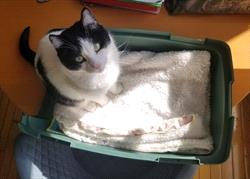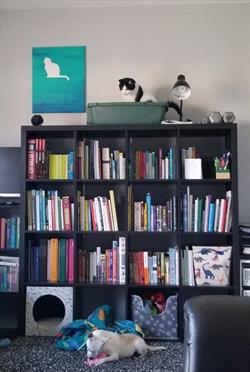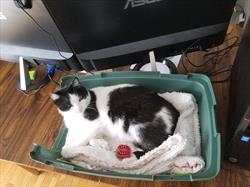Since indoor cats rarely leave the house, they often become stressed or anxious when they are taken to the veterinary hospital once a year. Cats learn by association, so the sudden appearance of the carrier tends to signal that something scary is happening. If the carrier is kept in a part of the home that the cat doesn’t have access to, such as the garage or attic, it can also bring strange smells, potentially adding more stress.
Training cats to love their carriers is beneficial for many reasons
- Decrease stress associated with veterinary visits
- More likely to be seen and treated for medical conditions early
- Easy containment during an emergency
- Decrease stress if hospitalized or boarded
- Provide more resting and hiding spots in the environment
- Allow for easier travel
Find the right carrier
- The carrier should be large enough for your cat to stand up and turn around.
- Hard plastic carriers with a non-slip mat are safest. Insecure footing can increase anxiety.
- Look for a carrier that can easily have the top removed. This makes it easier to keep the cat comfortable during examinations by the veterinarian.
A cat being introduced to the bottom of a carrier

A cat being introduced to the bottom of a carrier. Photo courtesy of Katharine Schwarz, RVT, KPA CTP, Elite Fear Free Certified Professional
How to train your cat to love their carrier
- Make the carrier a part of the environment! If the carrier is out all the time, then it is no longer a strange and scary object that predicts scary things.
- Start with just the bottom of the carrier with soft bedding. Place it in an area where your cat frequently chooses to rest. One favored spot is on top of a desk near your workstation. Sun-soaked locations or places where you spend a lot of time are also great spots.
- Leave treats in the carrier for your cat to discover on their own.
- Once your cat loves spending time in the bottom part of the carrier, introduce the top. Leave the door off of the carrier for now.
- Leave treats, or food puzzles, or toys inside the carrier for your cat to find throughout the day. You can also play with feather toys near or inside the carrier to encourage your cat to investigate.
- Play the “in and out” game by tossing a treat inside, then waiting for your cat to retrieve the treat. Continue tossing treats into the carrier until your cat chooses to wait in the carrier for the next treat.
- Add the door. While your cat is eating treats in the carrier, close the door briefly before they notice. Gradually build up duration in the crate with treats slowly, making sure that your cat does not appear distressed or worried at any point in the process.
- If at any time your cat appears distressed in the process, go back a step and start over.
A cat enjoying a carrier as a safe, tall perch

A cat enjoying a carrier as a safe, tall perch. Photo courtesy of Katharine Schwarz, RVT, KPA CTP, Elite Fear Free Certified Professional
Taking it on the road
- Add in some movement. Close the crate while your cat is eating treats and gently pick up the carrier while supporting the bottom. Don’t let the carrier swing. Start with small movements, then release your cat from the carrier. If your cat avoids entering the carrier again, go back to an easier level.
- Once your cat will happily enter the crate and is not phased by the carrier moving, start to incorporate car rides. Remember that leaving the home can be a big adjustment for many cats; train at your cat's pace.
The key is to build and maintain a positive association with the carrier to make your cat’s visit to the veterinarian as low stress as possible.
A carrier placed near a work station

A carrier placed near a workstation. Photo courtesy of Katharine Schwarz, RVT, KPA CTP, Elite Fear Free Certified Professional